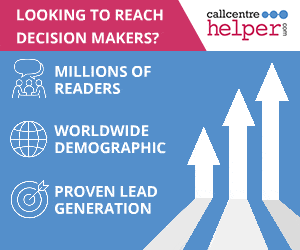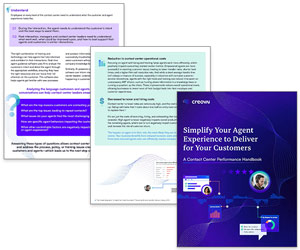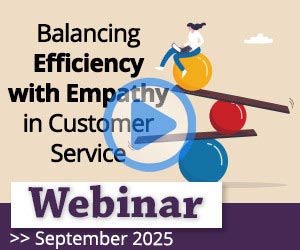“Empathy” is a word we throw around a lot in contact centres, but most of the time we’re talking about how agents should show it to customers. We train and coach them to listen actively, stay calm under pressure, and deliver great experiences.
But we also need to prioritize checking in on the agents themselves – as Pier Ragone, former Director of Contact Centre and Customer Relations at Porter Airlines Inc., explains…
As Leaders, We Have a Responsibility to Ask, “Are You OK?”

Burnout happens when we forget that the person on the phone is carrying more than just a headset. They’re carrying stress from work, challenges from home, and the emotional weight of every angry call.
If we expect our people to keep showing empathy all day, we need to make sure we are giving it back.
As leaders, we have a responsibility to ask the simplest, most important question: Are you OK?
It’s a small question that sends a big message. You matter. I see you beyond the metrics. It’s the starting point for preventing burnout and creating a culture where people feel safe, supported, and ready to perform at their best.
Empathy isn’t just smart for service. It’s smart leadership. And it pays off in retention, engagement, and performance.
So, how can contact centre professionals in coaching and team leadership roles bring that to life?
5 Quick Wins for Putting Your People First, Always
Here are some ideas on how you can kick-start empathy-first leadership in your contact centre:
1. Start With “Are You OK?”
A core leadership principle is to lead with care and show genuine curiosity. Reflect real interest in the person, not just their performance.
Remember, when you lead with an agenda, it can create distance.
But a simple question like “Are you OK?” can open the door to a conversation they may not have felt safe enough to start.
You don’t need to have all the answers. Sometimes, just being present and listening is enough. This one question creates psychological safety and reminds your team they’re valued beyond the metrics.
2. Coaching as Connection, Not Just Correction
This approach should be extended more formally into your structured one-on-ones and coaching sessions too.
Quite simply because, in high-stress environments, those scheduled sessions often become the only quiet space an agent has to truly be honest.
However, that only happens if you make room for it – and this means listening before jumping into performance gaps!
Coaching is a window into how your team is really doing.
So, instead of diving straight into numbers or QA, try asking, “How are things going for you lately?” or “What’s been on your mind at work?”
These small openings can lead to conversations that matter.
Coaching is not just about correcting performance. It is your chance to spot early signs of burnout, catch small struggles before they grow, and show that you are here to help them succeed. Not just evaluate them.
Good coaching is human. Always!
If you are looking to improve your contact centre coaching, read our article: Take Your Coaching Strategy to the Next Level
3. Flex Schedules With Empathy
People have a lot going on. Many are juggling responsibilities they prefer not to share. Caregiving. A side hustle. Managing their mental or physical health.
Offering flexibility where possible is one of the most practical ways to show empathy.
You do not have to sacrifice operational needs. Small accommodations like shift-swaps, variable shift types, temporary schedule adjustments, or occasional exceptions send a clear message… We see you, and we are willing to meet you halfway!
For advice on how to successfully plan, build and manage flexible schedules in the contact centre, read our article: How to Build Flexible Schedules in the Contact Centre
4. Protect Focus, Reduce Noise
Remember that agents want to do good work. But constant distractions, unnecessary updates, and irrelevant metrics pull them away from what matters.
As a leader, your job is to clear the noise and provide clarity. Protect their focus so they can deliver great service. When you reduce the mental clutter, you reduce stress.
5. Normalize Micro-Breaks
Everybody knows that not every “sick day” is about illness. Many agents call in well. They’re healthy, but they know they just can’t “people” today. They’re emotionally drained, and they need a reset.
Build policies and metrics where agents have both a set break and a pool of unscheduled micro-break minutes. No justification needed. Just time to breathe.
You cannot expect people to deliver peak empathy on every call without giving them space to recharge. It’s not slacking off. It’s smart leadership that prevents burnout.
How to Build Empathy Into Your Cultural Foundations
Of course, it’s not just about the quick wins. It’s about making sure empathy runs through your contact centre culture too.
Rethink QA as “Indicator” – Not “Indictment”
A good QA score reflects a good customer experience. It makes sense to set a baseline that your organization is comfortable with.
But a low score does not always mean poor performance. It might point to a training gap, a misalignment of skills, or even a personal struggle that deserves attention.
When you approach QA with curiosity instead of judgement, you shift the conversation from punishment to partnership. And that shift builds trust, not fear, in the long term.
Train Leaders in Empathy-Led Management
Empathy is not innate for every leader. But it can be taught. Emotional regulation, active listening, and handling emotional triggers are all skills that can be developed over time.
Invest in leadership training that goes beyond the technical. Teach people leaders how to recognize signs of burnout. Show them how to create safe spaces.
And at the very least, make sure they know how to truly listen, and not with their answer already running, but with real presence and attention.
These are not soft skills. They are leadership fundamentals. Just as critical as any KPI.
If you are looking for advice on developing empathy as a skill, read our article: How to Develop Empathy as a Skill in Your Frontline Teams
Create Safe Feedback Loops
Agents carry emotional weight every day. They need safe, structured ways to share what they are experiencing. Pulse surveys, 360 evaluations, and regular open forums can give them that space.
But asking for feedback is not enough. Leaders need to act on what they hear. And they need to show what changed as a result.
That kind of follow-through builds trust. Trust is what keeps people engaged, even when the work is hard.
Partner With HR to Prioritize Emotional Safety
The contact centre is its own ecosystem. It is fast-paced, emotionally charged, and often misunderstood by departments that do not live in it every day. HR can be one of your greatest allies, but only if they understand the environment you are working in.
That’s why leaders need to make it a priority to help HR understand what life in the contact centre actually looks and feels like. And HR needs to listen.
When both sides engage with curiosity and respect, policies begin to reflect the real needs of the people doing the work.
Support is not just about procedures. It is about understanding the pressure people are under and making room for human moments without assuming the worst.
Emotions can run a little hotter in a contact centre. That is not a red flag. That is the job. What matters is how we respond and how we recover.
When HR and Operations are working from the same playbook, empathy isn’t just a once-a-year survey measurement. It becomes part of the culture, every single day.
Show People What Good Looks Like
In contact centres, rewards and recognition cannot be an afterthought. Some centres have roles dedicated to recognition. People are in and out. Teams are shifting. New hires are watching.
Culture is being built in real time, and it resets every time someone new walks through the door!
As a leadership team, you need to keep showing people what good looks like – in metrics, in behaviours, and in the way people support each other. That means saying it often, showing it often, and celebrating it often.
The most powerful recognition is specific. It tells a story. It highlights what someone did, why it mattered, and how it connects to what the team values. Recognition becomes a teaching tool, not just a feel-good moment.
Recognition is not just about making someone feel good. It is about reinforcing shared standards and showing the team that you are paying attention to what matters. When done with intention, it becomes one of the clearest ways to lead.
If you are looking for advice on building an interconnected environment of communication, motivation, recognition and teamwork, read our article: 9 Ways to Create a Thriving Contact Centre Culture
Empathy Cannot Stop With the Customer!
Empathy has always been part of customer service. But it cannot stop with the customer.
If we want agents to show up with patience, care, and consistency, they need to feel that same energy coming from their leaders. That means listening, asking “Are you OK?” and meaning it, as well as building systems and processes that support people – not just track them.
Empathy is not a soft skill. But it is a learnable one. And it is how we build strong teams that last.
Written by: Pier Ragone, former Director, Contact Centre & Customer Relations at Porter Airlines Inc.
For more advice and information on developing your contact centre leaders, read these articles next:
- Top Reads to Boost Your Contact Centre Leadership Skills
- 5 Things Creative Leaders Do Differently
- How to Coach Resilient Contact Centre Team Leaders
Author: Pier Ragone
Reviewed by: Jo Robinson
Published On: 16th Jun 2025 - Last modified: 15th Sep 2025
Read more about - Call Centre Management, Empathy, Employee Engagement, Health Wellbeing and Stress, Leadership, Management Strategies, Pier Ragone, Team Management, Top Story, Training and Coaching








































